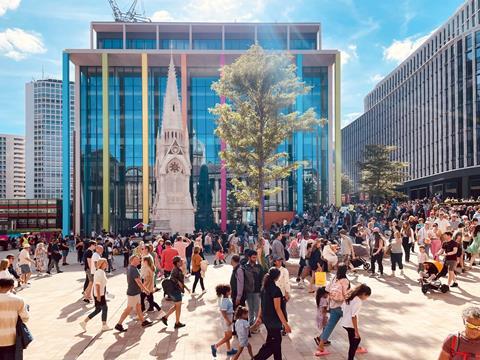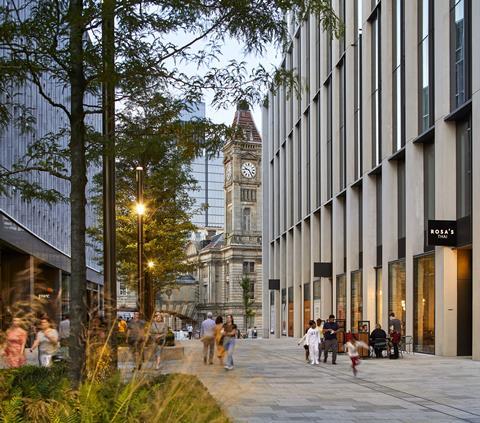We need to stop viewing public space as being about discrete destinations, and start seeing it as a complex and interconnected web, writes Dav Bansal

The role of the public realm in shaping the contemporary city is changing. Historically, ideas of enclosure and control have shaped the architecture of city squares, parks, and pedestrianised areas, into set places, in isolation from one another. It is a realm which has typically been ‘over there’ – between some buildings, behind a fence, across the road – awaiting activation; a place to go to, often designed (materially and socially) to serve a relatively select cultural and commercial agenda.
In order to harness the power of the public realm in urban regeneration, we must begin to conceptualise it as an infrastructure in its own right, one which connects the city across multiple dimensions: liveability, sustainability, mobility and culture. It needs to be a realm that is recognised for its air quality, transport connectivity, and social diversity, as well as for its monumental buildings, panoramic views, and headline tenants, if the opportunity is there.
With good design, policy and investment interventions directed at it, there is an opportunity for the public realm to be a crucial driver in city-wide transformation; making our cities more sustainable, equitable and holistically valuable places, both reflecting, and acting as a catalyst for the society we are, and aspire to be.

At Glenn Howells Architects, we’ve been witness to multiple cycles of change in our home city of Birmingham. At the time of our founding in 1990, the city was two years into the ‘Highbury Initiative’ planning framework. Ahead of its time, the initiative promoted use of the city centre to expand beyond its reliance solely on business and retail, to incorporate leisure and wellbeing.
It also championed pedestrian over vehicular mobility, and recommended the demolition of the ‘concrete collar’ inner ring road. Such interventions paved the way for the urbanism we aim for in the city, and indeed globally, today.
In 2011, the Big City Plan (BCP) was introduced to succeed the Highbury Initiative. Where previously the planning mantra had been to divide peripheal zones, the BCP aimed to draw them closer to each other, and to the city core.

The public realm would be key in this effort, with 65,000 sqm of new and improved public space connecting 1.5 million square metres of new floorspace, 50,000 jobs, 28km of walking and cycling routes, 5,000 new homes, and a projected £2.1 billion contribution to the city’s economy.
The Paradise masterplan, the first phase of which completed in 2021, has been at the centre of this transformation. Designed to create an infrastructure from which the city’s environmental, cultural and economic landscape can thrive, Paradise opens up the public realm between the historic Chamberlain Square and neighbouring Centenary Square, providing better sight lines and pedestrian access, as well as more links to public transport and better spaces to platform cultural events.
When Birmingham hosted the Commonwealth Games (CWG) this summer, the celebration provided an obvious articulation of how the rejuvenated public realm can contribute to citywide regeneration. With over 5 million people travelling to Birmingham over the two weeks, Paradise became a hive of activity, and in many ways the spirit of the Games was manifest in its truest sense; public ceremony and celebration.

However, in order to truly start utilising the public realm for connecting and mobilising the entire city, we need to start thinking, and designing, beyond obvious headline events. We need to start thinking about how the public realm in central urban areas – such as Paradise – connects to peripheral ones, and become active agents in citywide regeneration.
In the development of Warners Fields, a new riverside neighbourhood in Digbeth, Glenn Howells Architects is working with Birmingham City Council and Dandara Living to open up a forgotten urban river to the public with footpaths, new river crossings, shops and restaurants, and 1,300 new homes. Over 50% of the project is devoted to blue and green pedestrian spaces, with buildings for cycling infrastructure also included in the masterplan, alongside public transport connections and future planning for HS2.
Connecting high-density living with sustainable public transport, and dependable connections to other parts of a the city is integral to the environmental and social sustainability of the built environment. The public realm has a fundamental part to play in that process, and when cultural, creative, technological and financial economies are both driving contemporary cities, and dependent on a progressive public realm to thrive, then a virtuous circle of ongoing regeneration is created.

This is what makes the local, peripheral public realm every bit as integral to our future city as those in the centre. One cannot be designed without careful consideration of how it connects to the other. It is only when considered in this manner that the public realm will be transformed from a place in need of activation, into an activator of place.
Being a part of Birmingham’s journey has altered our perspective on the power of the public realm in shaping citywide regeneration – shifting our outlook on it as static space, to dynamic infrastructure. As Birmingham embarks on the next cycle of city planning (‘Our Future City Plan - Central Birmingham 2040’, launched 2021), it is vital that the public realm is harnessed, to not only build on the precedents set out in the Highbury Initiative and Big City Plan but to prioritise enhancing nature, health and wellbeing.
The OFCP’s vision delves into the key opportunities and challenges facing the city over the coming decades. One of the key objectives is to extend city centre connections beyond the core into the neighbouring local centres that have previously suffered from lack of investment in infrastructure.
By doing so, disparate urban neighbourhoods will be stitched together through active travel routes and inclusive public realm, and will be underpinned by sustainable densities of homes and employment opportunities. This will manifest into a city of thriving communities with growth for all, underlining Birmingham’s long-standing status as a city of innovation.
Postscript
Dav Bansal is a partner at Glenn Howells Architects
















No comments yet